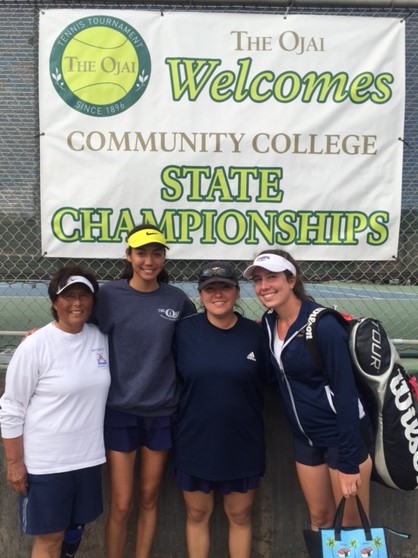When College of the Canyons women’s tennis coach Patty LaBat was looking for a strong doubles player to fill out her roster two years ago, she kept coming back to the name of her friend and occasional doubles partner Seleste Sakato.
The only problem was the then 65-year-old, who was in high school before LaBat was born, works full-time as an accountant for small business in the Santa Clarita Valley and has her Masters’ degree. “So I said no!” said Sakato.
But LeBat persisted and finally got Sakato to relent and sign on for 12 units to play a full season for Canyons last spring. In just its second season of existence Canyons (9-7, 9-5 WSC) finished third in the Western State Conference team standings behind champions Santa Barbara City (16-3, 14-0) and runner-up Bakersfield (17-4, 12-2).
Sakato was a big reason for the success of the team. “She said I really need you and originally told me I would just play doubles,” Sakato recalls. “But we were short players so I played No. 5 singles, which was fine and I did pretty well at that position. Some of the other coaches complained and said I didn’t belong at No. 5 but higher in the lineup. But Patty argued, ‘She’s 65!’ ”
She could have also argued that Sakato didn’t start playing tennis until her mid-30s, after meeting and later marrying her teaching-pro wife of 33 years ago former UCLA player Betsy Skidmore.

Sakato said she got different reactions from the opposition, some who resented having to play someone who could be their grandmother. “In my singles they weren’t too happy I was beating them,” said Sakato , who grew up in Reseda and currently resides in Agua Ducle. “They thought I was being mean because when they questioned me about something, I knew the rules of tennis because I’ve been playing so long.”
Sakato played No. 1 doubles with freshman Una Stanisavljevic, who played at West Ranch High School in Valencia a season ago. The pairing went 7-3 in conference and 4-2 in the postseason advancing to the Western State Conference doubles final and winning one round at the Ojai CCCAA State Championships. “We faced the No. 1 seeds and didn’t get a very good draw and they ended up winning the tournament,” Sakato said.
Because of the age gap between her and her teammates, Sakato observed several interesting differences, including:
- Sakato, who hits with a one-handed backhand, has for years perfected a slice backhand, something that was foreign to the other players she played with and against. When LeBat was asked to give a quote about her player, she mentioned the slice, saying ““Seleste was an inspiring teammate who demonstrated the value of perseverance, fighting for the right to participate and the short slice backhand.”
- Today’s young players aren’t taught to serve and volley. “I’m a serve and volleyer at 66,” Sakato said. “The kids today don’t want to be at the net. One time, an opponent just cracked a ball right at my partner at the net and she turned to me and said, ‘I hate volleying.’ So I said, ‘Then you stand here and I’ll be at the net.’ I don’t care how hard they hit it to me at the net. It doesn’t matter. I love to volley so I’m not afraid to be up there no matter who’s on the other side.”
- Players need to lighten up a little. “I felt like the girls don’t talk to one another, so I tried to get the girls to talk and have fun,” Sakato said. “Sometimes they would be too serious. As a group during Ojai we stayed at a house in Oxnard. We had a lot of fun playing other games like Ping Pong and Smashball. This is supposed to be fun.”
Sakato made the tough decision not to return for her sophomore season of college tennis in 2020. “I would have to maintain a minimum of 12 units and I just don’t have the time,” she said. “I don’t have that many hours to commit.”

So starting in January, Sakato will be LaBat’s assistant coach. “This year Seleste can help the team understand the workings of doubles, a game suited to experience and thinking on the court,” Labat said.
Sakato won’t have to repeat a funny occurrence that happened during her physical that each player has to take to submit for eligibility. “They asked for my medical insurance card. So I handed them my MediCare card,” Sakato said. “I said, ‘I bet you haven’t seen one of these before.’ ”
